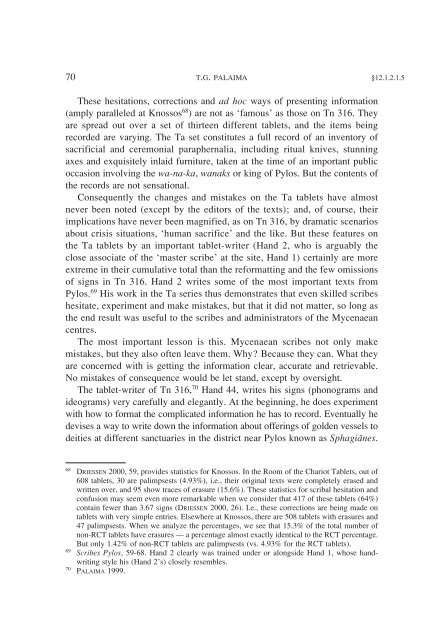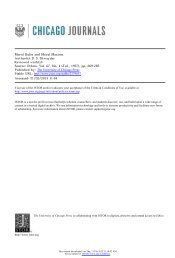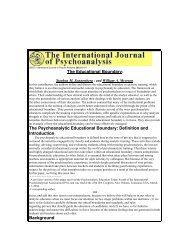A Companion to Linear B - The University of Texas at Austin
A Companion to Linear B - The University of Texas at Austin
A Companion to Linear B - The University of Texas at Austin
Create successful ePaper yourself
Turn your PDF publications into a flip-book with our unique Google optimized e-Paper software.
70 T.G. PALAIMA §12.1.2.1.5<br />
<strong>The</strong>se hesit<strong>at</strong>ions, corrections and ad hoc ways <strong>of</strong> presenting inform<strong>at</strong>ion<br />
(amply paralleled <strong>at</strong> Knossos 68 ) are not as ‘famous’ as those on Tn 316. <strong>The</strong>y<br />
are spread out over a set <strong>of</strong> thirteen different tablets, and the items being<br />
recorded are varying. <strong>The</strong> Ta set constitutes a full record <strong>of</strong> an inven<strong>to</strong>ry <strong>of</strong><br />
sacrificial and ceremonial paraphernalia, including ritual knives, stunning<br />
axes and exquisitely inlaid furniture, taken <strong>at</strong> the time <strong>of</strong> an important public<br />
occasion involving the wa-na-ka, wanaks or king <strong>of</strong> Pylos. But the contents <strong>of</strong><br />
the records are not sens<strong>at</strong>ional.<br />
Consequently the changes and mistakes on the Ta tablets have almost<br />
never been noted (except by the edi<strong>to</strong>rs <strong>of</strong> the texts); and, <strong>of</strong> course, their<br />
implic<strong>at</strong>ions have never been magnified, as on Tn 316, by dram<strong>at</strong>ic scenarios<br />
about crisis situ<strong>at</strong>ions, ‘human sacrifice’ and the like. But these fe<strong>at</strong>ures on<br />
the Ta tablets by an important tablet-writer (Hand 2, who is arguably the<br />
close associ<strong>at</strong>e <strong>of</strong> the ‘master scribe’ <strong>at</strong> the site, Hand 1) certainly are more<br />
extreme in their cumul<strong>at</strong>ive <strong>to</strong>tal than the reform<strong>at</strong>ting and the few omissions<br />
<strong>of</strong> signs in Tn 316. Hand 2 writes some <strong>of</strong> the most important texts from<br />
Pylos. 69 His work in the Ta series thus demonstr<strong>at</strong>es th<strong>at</strong> even skilled scribes<br />
hesit<strong>at</strong>e, experiment and make mistakes, but th<strong>at</strong> it did not m<strong>at</strong>ter, so long as<br />
the end result was useful <strong>to</strong> the scribes and administra<strong>to</strong>rs <strong>of</strong> the Mycenaean<br />
centres.<br />
<strong>The</strong> most important lesson is this. Mycenaean scribes not only make<br />
mistakes, but they also <strong>of</strong>ten leave them. Why? Because they can. Wh<strong>at</strong> they<br />
are concerned with is getting the inform<strong>at</strong>ion clear, accur<strong>at</strong>e and retrievable.<br />
No mistakes <strong>of</strong> consequence would be let stand, except by oversight.<br />
<strong>The</strong> tablet-writer <strong>of</strong> Tn 316, 70 Hand 44, writes his signs (phonograms and<br />
ideograms) very carefully and elegantly. At the beginning, he does experiment<br />
with how <strong>to</strong> form<strong>at</strong> the complic<strong>at</strong>ed inform<strong>at</strong>ion he has <strong>to</strong> record. Eventually he<br />
devises a way <strong>to</strong> write down the inform<strong>at</strong>ion about <strong>of</strong>ferings <strong>of</strong> golden vessels <strong>to</strong><br />
deities <strong>at</strong> different sanctuaries in the district near Pylos known as Sphagianes.<br />
68 DRIESSEN 2000, 59, provides st<strong>at</strong>istics for Knossos. In the Room <strong>of</strong> the Chariot Tablets, out <strong>of</strong><br />
608 tablets, 30 are palimpsests (4.93%), i.e., their original texts were completely erased and<br />
written over, and 95 show traces <strong>of</strong> erasure (15.6%). <strong>The</strong>se st<strong>at</strong>istics for scribal hesit<strong>at</strong>ion and<br />
confusion may seem even more remarkable when we consider th<strong>at</strong> 417 <strong>of</strong> these tablets (64%)<br />
contain fewer than 3.67 signs (DRIESSEN 2000, 26). I.e., these corrections are being made on<br />
tablets with very simple entries. Elsewhere <strong>at</strong> Knossos, there are 508 tablets with erasures and<br />
47 palimpsests. When we analyze the percentages, we see th<strong>at</strong> 15.3% <strong>of</strong> the <strong>to</strong>tal number <strong>of</strong><br />
non-RCT tablets have erasures — a percentage almost exactly identical <strong>to</strong> the RCT percentage.<br />
But only 1.42% <strong>of</strong> non-RCT tablets are palimpsests (vs. 4.93% for the RCT tablets).<br />
69 Scribes Pylos, 59-68. Hand 2 clearly was trained under or alongside Hand 1, whose handwriting<br />
style his (Hand 2’s) closely resembles.<br />
70 PALAIMA 1999.

















